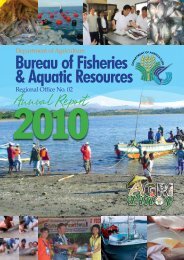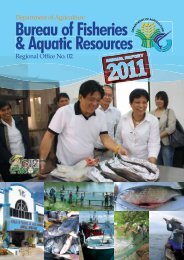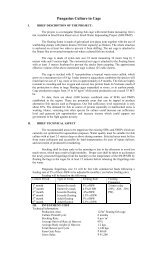Kalap Vol. 10, No. 01, January-June 2009 556kb - Bureau of ...
Kalap Vol. 10, No. 01, January-June 2009 556kb - Bureau of ...
Kalap Vol. 10, No. 01, January-June 2009 556kb - Bureau of ...
You also want an ePaper? Increase the reach of your titles
YUMPU automatically turns print PDFs into web optimized ePapers that Google loves.
6<br />
Recognizing the burden borne by<br />
fish farmers from high input costs<br />
particularly feeds, the <strong>Bureau</strong> <strong>of</strong><br />
Fisheries and Aquatic Resources has<br />
included in its CY <strong>2009</strong> plans the<br />
widespread promotion <strong>of</strong><br />
duckweeds as supplemental feeds<br />
for tilapia, bangus, pangasius and<br />
carp.<br />
Duckweeds (Lemna spp.) are<br />
tiny free-floating plants with reported<br />
crude protein content <strong>of</strong> 18 – 42<br />
percent. Earlier study made by the<br />
bureau’s fish farm in Iguig, Cagayan<br />
has determined the viability <strong>of</strong> using<br />
this rapidly-reproducing plant as<br />
alternative diet without adverse effect<br />
on the growth <strong>of</strong> tilapia.<br />
Said study has determined<br />
optimum feeding mixture at 50<br />
percent fresh duckweeds and 50<br />
percent commercial feeds. The<br />
feeding combination even achieved<br />
higher growth rate compared to the<br />
treatment that used pure commercial<br />
feeds.<br />
On monetary terms, a 1,000<br />
square meter semi-intensive<br />
fishpond using this feed combination<br />
can easily cut feed expenses by more<br />
than <strong>10</strong> thousand pesos (20+ bags)<br />
on 1 culture cycle (4 to 5 months) or<br />
more than <strong>10</strong>0 thousand pesos for 1<br />
hectare.<br />
“Considering that costs <strong>of</strong><br />
commercial feeds have risen by less<br />
than <strong>10</strong> percent to 25 percent based<br />
on 2008 figures, while retail price <strong>of</strong><br />
tilapia had remained constant, the<br />
50% savings will certainly mean a lot.<br />
Duckweeds will also help us address<br />
dependence on imported corn as<br />
KALAP <strong>January</strong> - <strong>June</strong> <strong>2009</strong><br />
BFAR 2 outlines plans for ’09<br />
TUGUEGARAO CITY, CAGAYAN – Fisherfolk in<br />
Cagayan Valley can expect higher pr<strong>of</strong>itability for the coming<br />
months as the fisheries bureau in the region has targeted the<br />
introduction <strong>of</strong> several cost-reduction and productivity<br />
enhancement technologies for <strong>2009</strong>.<br />
raw material for feeds which is<br />
currently around 90 percent <strong>of</strong> total<br />
national requirement,” BFAR RO2<br />
Regional Director Jovita Ayson said.<br />
As targeted during the Planning<br />
Workshop with LGUs last Feb. 3 &<br />
4 in Aparri, Cagayan, BFAR RO2<br />
will establish <strong>10</strong> duckweed demo<br />
sites for the whole region.<br />
Other aquaculture technologies<br />
to be introduced or promoted are:<br />
Polyculture – defined as the<br />
scientific process <strong>of</strong> raising two or<br />
more non-competing fishery species<br />
in single / common culture system,<br />
polyculture can potentially raise<br />
farmer’s income through the optimum<br />
utilization <strong>of</strong> inputs and culture area.<br />
Last year’s polyculture projects<br />
<strong>of</strong> BFAR RO2, involving the<br />
combination <strong>of</strong> ulang<br />
(Macrobrachium rosenbergii)–<br />
tilapia–carp and tilapia–common<br />
carp–African catfish, had achieved<br />
93 & 58 percent additional net<br />
income compared to pure semiintensive<br />
tilapia farming.<br />
Pangasius culture – a fast<br />
growing and hardy fish, pangasius<br />
has been proven to be feasible under<br />
fishpond, fish cage and organic<br />
culture systems in region 02<br />
conditions.<br />
To address main constraint<br />
which is the inadequate supply <strong>of</strong><br />
fingerlings, BFAR RO2 will establish<br />
a hatchery at its station in San Mateo,<br />
Isabela. The bureau together with the<br />
Office <strong>of</strong> Provincial Agriculturist -<br />
Cagayan had also proposed to the<br />
agriculture department the<br />
construction <strong>of</strong> a pangasius hatchery<br />
at the OPA facility in Bantay,<br />
Camalaniugan.<br />
Other aquaculture technologies<br />
to be introduced are urban, upland<br />
and mangrove aquaculture, and 45days<br />
delayed feeding technology.<br />
The agency will also introduce culture<br />
<strong>of</strong> high value species such as<br />
abalone, sea urchin, mud crab, and<br />
sea urchin.<br />
To support its flagship fingerling<br />
production and dispersal program,<br />
Ayson bared the rationalization <strong>of</strong> 6<br />
BFAR fish farms in the region with<br />
the aim to maximize utilization <strong>of</strong> area<br />
and hence, increase fingerling<br />
production.<br />
The agency has targeted the<br />
production <strong>of</strong> 12.29 million<br />
fingerlings and 1 million oyster spats<br />
this year as measure to increase<br />
dispersal to its LGU and fish farmer<br />
clientele in the region.<br />
On the coastal and marine front,<br />
the fisheries bureau will distribute<br />
environment friendly fishing gears<br />
such as fish trap, troll line, long line<br />
and gill nets in addition to the<br />
implementation <strong>of</strong> regulatory<br />
activities. BFAR will also continue<br />
with its widespread distribution and<br />
installation <strong>of</strong> fish aggregating<br />
devices or ‘payao’.<br />
Ayson said that the interventions<br />
will help address ongoing economic<br />
crisis and will enable the region<br />
achieve 66,400 MT production for<br />
<strong>2009</strong> or an increment <strong>of</strong> 7 percent.<br />
2008 fisheries production level<br />
in region 02 stands at 62,057.96<br />
MT which corresponds to 56.49<br />
percent fish sufficiency level.






